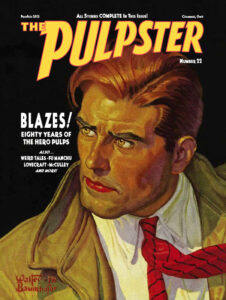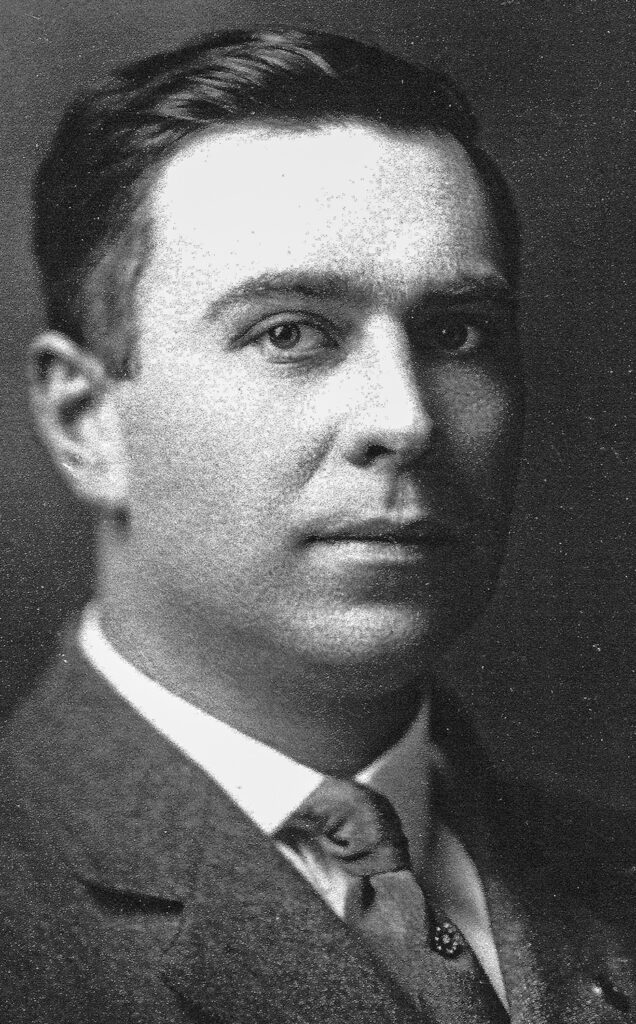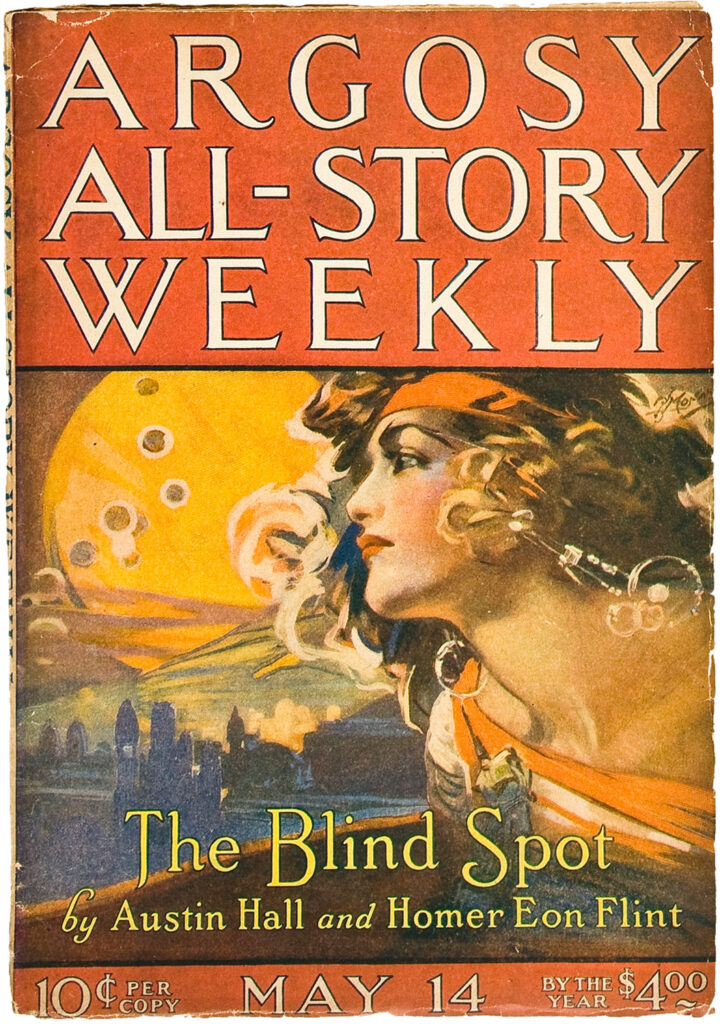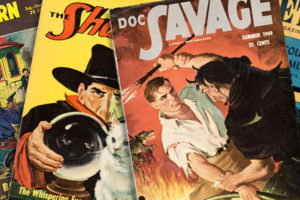Homer Eon Flint found inspiration in his short life to write stories “ahead of their time.”
Science fiction’s No. 1 spokesman and promoter Forrest J Ackerman called “The Blind Spot” by Austin Hall and Homer Eon Flint (serialized in Argosy All-Story Weekly in 1921) “a fabulous novel.”
Since then, “The Blind Spot” has been republished at least seven times, and the fantasy novel, about a portal between Earth and a parallel universe, has taken on legendary status.
Of no less interest to fans of science fiction’s earliest days is the mystery behind Flint’s death at age 36. If there is something to the blind spot in the eye which fascinated Hall and Flint, perhaps Flint (or Flindt, as he was born) could speak from the parallel universe of his imagination about what really happened at the bottom of a lonely Northern California canyon on March 27, 1924.
Why have I chosen to report on this overweight, even-tempered shoe repairman and inventor, this failed journalist and draftsman who married a schoolteacher and fathered three children? His stories about life on Mars and Venus, trips to Mercury, the deadly consequences of a shift in the moon’s orbit, genetic engineering, and an alternative theory of Adam and Eve’s origin demonstrated his prodigious imagination, but that isn’t the reason.
Fanzine flashback
 This article originally appeared in The Pulpster (#22) for PulpFest 2013. It has been updated. Reprinted with permission.
This article originally appeared in The Pulpster (#22) for PulpFest 2013. It has been updated. Reprinted with permission.
Homer was my grandfather.
When he died, my mother was not yet 6 years old. Max, Homer’s oldest child, devoted much of his life to developing and publishing his own theory of evolution. Vella (my namesake and aunt) was just 3 when her daddy died.
His wife, Mabel, had taught in Truckee, Calif., for three years when they married. It was she who noticed a newspaper article about the demand for movie scenarios by the fledgling film industry, and persuaded her husband to send away for a set of instructions. His first published effort, The Joke That Spread, sold to the Vitagraph Co. in October 1912 for $10. He sold several more scenarios in 1913 before the demand dried up. Unfortunately, no copies of When Chemistry Counted, The Footprint Clue, With the Crooks’ Trick, Fast Fright 3205, A Six Shot Hero, The Cipher Telegrams, or To Save the Road are known to exist.
At the time of his death, economic necessity had separated the family by 230 miles. Homer was living with his sister in San Jose and working at his brother’s shoe shop, while Mabel and the children were in the small Sierra Mountain town of Washington, where she’d been hired to teach. The many letters between husband and wife speak of a devoted, practical, and optimistic couple.
By early 1924, the separation was about to end. Homer had been hired to drive the daily stage between Washington and the nearby, larger town of Nevada City. Rather than bemoaning leaving bustling San Jose and his network of writing friends, he wrote Mabel, “Say — I wish New York would come through quick. You make me long to get away from this ‘world of trains and noises.’ That’s it exactly — noise. I want to get out of it and get my nerves steady again. And the beauty of it — the thing to do is to appreciate it to the full, that scenery. Our confounded automobiles rush through it and don’t let us have any of it to keep.”
Sensationalist press of the day noted that his work had been saturated with the occult and speculated he may have killed himself “as a result of an overwhelming desire to visit the mystery world that lies beyond the pale” (Oakland Tribune, May 11, 1924).
Channeling his imagination
Homer credits his wife with channeling his imagination in a publishable direction, and one would expect his letters to touch on his interest in the occult if it consumed him; they don’t. When his letters did mention writing issues, the focus was on practical matters: how far he’d progressed in a given story, nibbles and rejections, the experiences of writer friends, and, to their shared excitement, the sale of “The Money-Miler” shortly before Homer’s death (published in Flynn’s as a three-part serial, Oct. 4-18, 1924), which netted the family $400.
Checklist: Homer Eon Flint in the pulps
- “The Planeteer,” All-Story Weekly, March 9, 1918
- “The Coupling,” The Overland Monthly, May 1918
- “King of Conserve Island,” All-Story Weekly, Oct. 12, 1918
- “The Lord of Death,” All-Story Weekly, May 10, 1919
- “The Queen of Life,” All-Story Weekly, Aug. 16, 1919
- “The Man in the Moon,” All-Story Weekly, Oct. 4, 1919
- “The Greater Miracle,” All-Story Weekly, April 24, 1920
- “Slick Meadows,” Short Stories, May 1920
- “Comedy Cash,” Short Stories, July 1920
- “The Blind Spot” with Austin Hall, Argosy All-Story Weekly, May 14-June 18, 1921 (released in book form by Prime Press, 1951, and Ace Books 1964)
- “The Devolutionist,” Argosy All-Story Weekly, July 23, 1921
- “The Emancipatrix,” Argosy All-Story Weekly, Sept. 3, 1921
- “Old Man Pythagoras,” Short Stories, Dec. 25, 1921
- “Black Gold,” Argosy All-Story Weekly, March 25, 1922
- “The Missing Mondays,” Argosy All-Story Weekly, Jan. 20-27, 1923
- “Out of the Moon,” Argosy All-Story Weekly, Dec. 15, 1923-Jan. 5, 1924
- “The Money-Miler,” Flynn’s, Oct. 4-18, 1924
- “The Nth Man,” Amazing Stories Quarterly, Spring 1928

Modern American Literature says that Homer’s stories “speculate on the success of political ideologies in imagined galactic settings.” In a 1996 Fantasy Commentator article, researcher, bibliographer, and historian Mike Ashley called Homer “creative and inventive,” and noted that “The Planeteer” was “a remarkable story, especially for a first fiction sale outside of movie scenarios, and shows the depth of Flint’s unbridled imagination. … The novel teems with super-scientific concepts and is one of the earliest examples of cosmic science fiction.”
Although his first two stories sold within days of each other — “The Coupling” to Overland Monthly (May 1918) and “The Planeteer” to All-Story Weekly (March 9, 1918) — and the proceeds paid for an earlier emergency appendectomy, Homer didn’t quit his day job. Ashley says that if Homer lived in the days of Amazing Stories, he would have become one of its main contributors. Homer once wrote a friend that, “I am more and more convinced that a man should follow fiction as an avocation rather than a vocation. It isn’t in human nature to do your best at something which you’ve got to do. The world’s finest work has always been done by someone who was simply riding a hobby.”
Writing to educate
Homer read H.G. Wells’ books and those of H. Rider Haggard, Jules Verne, and Arthur Conan Doyle. When interviewed for the History of Santa Clara County, Calif. in 1922, he said the purpose in his fiction writing was to educate: “Sometimes it is only a very little point that can be brought out, but it all helps to make folks willing to change their minds, and in that way pave the way for the new order of things. Meanwhile, however, we must not fail to hold fast to that which is good.”
 Ashley called Homer “one of the most creative talents in fantastic fiction.” He noted that in Everett Bleiler’s Science Fiction: The Early Years, Homer was called “in many ways the outstanding writer of s-f in the Munsey pulp magazines,” as his stories were always exciting and “teemed with ideas way ahead of their time.”
Ashley called Homer “one of the most creative talents in fantastic fiction.” He noted that in Everett Bleiler’s Science Fiction: The Early Years, Homer was called “in many ways the outstanding writer of s-f in the Munsey pulp magazines,” as his stories were always exciting and “teemed with ideas way ahead of their time.”
Unfortunately, my grandfather’s time was too short, and although I would prefer not to revisit his death, the story of his life would be incomplete without it.
What is known about Homer Flint’s death is based on the word of the only witness — taxi driver E.L. Handley, a known gangster who died in prison. According to Handley, Homer asked to be taken into Dublin Canyon near Castro Valley so he could visit a friend. Once in the canyon, Homer told Handley to turn onto a dirt road, then pulled a gun and ordered Handley to get out. Homer attempted to drive away with the taxi but crashed.
My sister and I collected every newspaper article we could find about the death investigation. The final piece, which appeared in the April 4, 1924, Mercury Herald, stated: “Flindt Found to Have Been Driver of Wrecked Auto: Coroner’s Jury Hears Testimony Concerning Death of San Jose Author. No New Developments. Witnesses at Pleasanton Investigation Corroborate Published Stories.”
Homer Eon Flindt died as a result of a “broken back sustained when the automobile he was driving went off the grade, crushing him under the overturned car, and we are unable to place the responsibility for the accident.” According to the newspapers, the county sheriff and district attorney disagreed, with the sheriff believing Handley’s story while the D.A. did not.
None of that mattered to Homer’s widow and three children, and Mabel’s last letter to her husband, written two days before his death, stands as testimony of what was lost:
Well, I hope we see you on the stage Saturday and anyway we’ll be listening to the phone Friday. Maybe a letter that comes tomorrow will tell me when you’ll start from San Jose. Love in big armfuls and kisses from your dreaming family and from her who soon will be. XXX XXX XXX XXX, Mabel.
What is my conclusion? I have detailed that in the biography Grandfather Lost (Musa Publishing, 2012). Bottom line, I believe Grandpa was the victim of a robbery gone wrong (it’s possible that he had $300 in cash on him from selling his car) or Handley murdered him for that money.
Grandpa’s death is a part of the past. Today, his entire body of work lives on in the electronic age. Musa Publishing initially began reprinting his stories as ebooks. Then Wildside Press collected them in an ebook, The 26th Golden Age of Science Fiction Megapack: 22 Early Science Fiction & Adventure Tales by Homer Eon Flint, which includes Grandfather Lost and several of Flint’s unpublished stories.
About the author
Vella Munn followed in the footsteps of her grandfather, Homer Eon Flint, and has had over 50 fiction books and novellas published under her own and several pen names. Visit her website, Vella-Munn.com.





